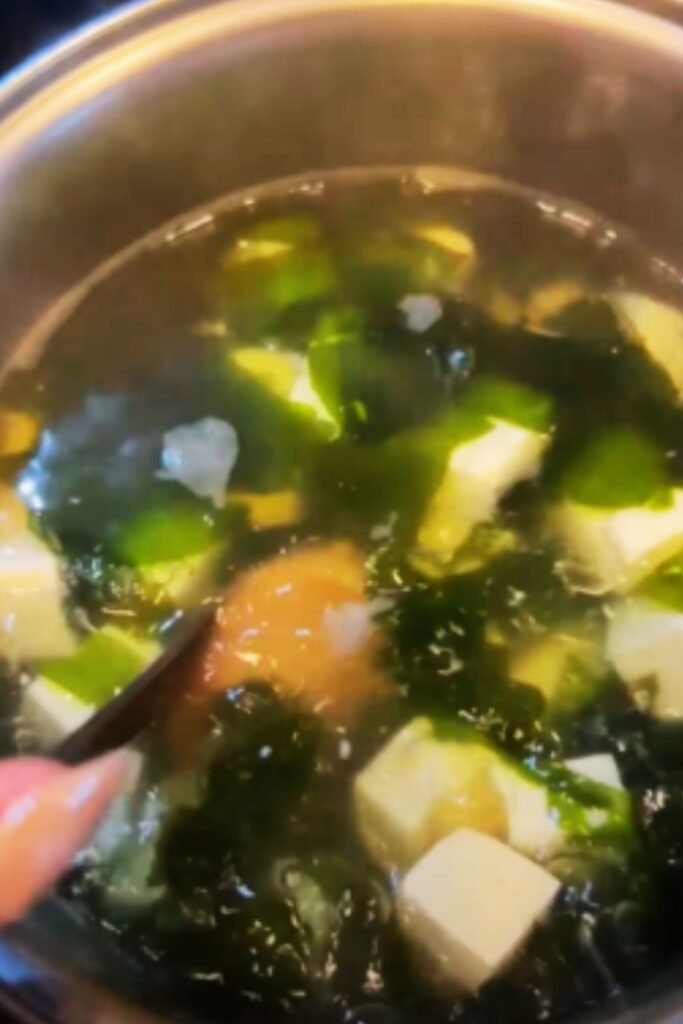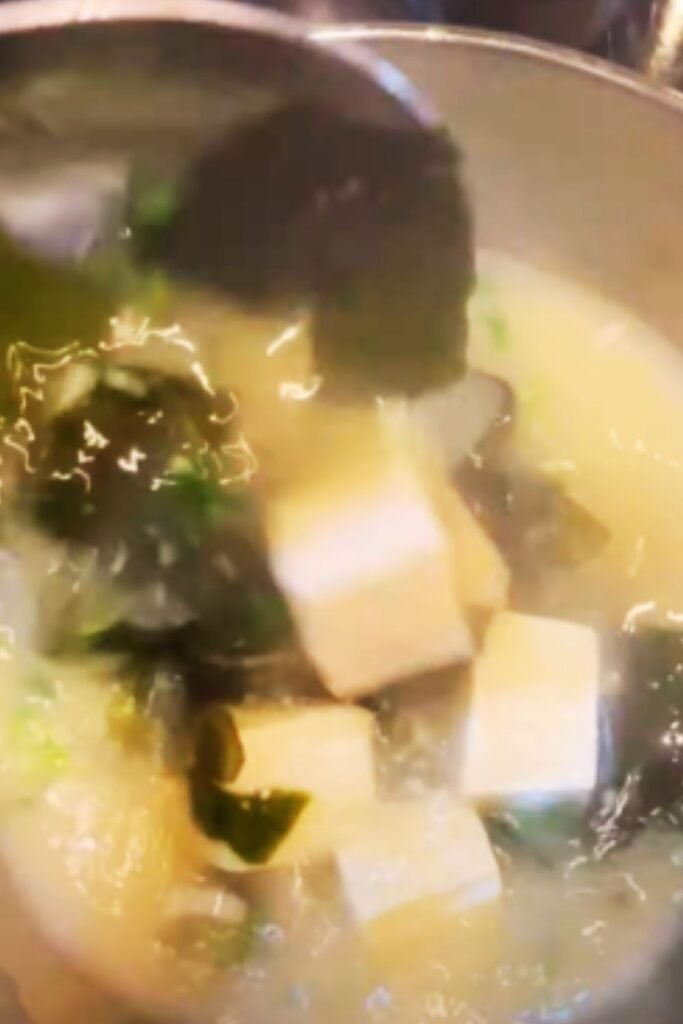There’s something magical about a steaming bowl of miso soup. The aromatic broth, delicate umami flavor, and nourishing ingredients create a harmony that satisfies both body and soul. As someone who’s been cooking Japanese cuisine for years, I’ve perfected the art of making authentic miso soup in just 10 minutes—without sacrificing an ounce of flavor.
Today, I’m sharing my go-to recipe for quick miso soup, complete with variations, nutritional benefits, and tips to help you master this Japanese staple. Whether you’re craving comfort food after a long day or need a quick appetizer before a meal, this 10-minute miso soup recipe will become your new best friend in the kitchen.
The Magic of Miso
Before diving into the recipe, let’s talk about the star ingredient: miso paste. This traditional Japanese seasoning is made by fermenting soybeans with salt and koji (a type of fungus). The result is a thick, flavorful paste that forms the foundation of countless Japanese dishes.
Miso isn’t just delicious—it’s also packed with health benefits:
- Rich in essential minerals and vitamins (B vitamins, vitamin E, K)
- Contains beneficial probiotics from fermentation
- Provides plant-based protein
- Supports digestive health
- May boost immunity and reduce inflammation
The fermentation process can last anywhere from a few months to several years, resulting in different varieties of miso:
| Miso Type | Color | Fermentation Time | Flavor Profile | Best Uses |
|---|---|---|---|---|
| Shiro (White) | Light beige | 1-3 months | Mild, slightly sweet | Delicate soups, dressings |
| Aka (Red) | Reddish-brown | 1-3 years | Rich, pronounced, savory | Hearty soups, marinades |
| Awase (Mixed) | Medium brown | Varies | Balanced | All-purpose, everyday miso soup |
| Genmai (Brown) | Dark brown | 1+ years | Earthy, nutty | Robust dishes, vegetable dishes |
| Hatcho | Very dark brown | 2+ years | Strong, complex | Traditional dishes, glazes |
For beginners, I recommend starting with Awase or Shiro miso—they’re versatile and less intense than their darker counterparts.
Essential Ingredients for 10-Minute Miso Soup
The beauty of miso soup lies in its simplicity. You only need a handful of ingredients:
Core Ingredients
- Dashi (Japanese stock): The backbone of miso soup
- Miso paste: The soul of the soup
- Tofu: Adds protein and substance
- Green onions: Provides freshness and color
- Wakame (dried seaweed): Offers minerals and texture
Dashi: The Foundation
Authentic miso soup begins with dashi, a simple Japanese stock that provides a savory base. While homemade dashi is wonderful, for our 10-minute version, these convenient options work perfectly:
- Instant dashi granules: Just dissolve in hot water
- Dashi stock packets: Similar to tea bags, steep in water
- Bottled dashi concentrate: Dilute with water following package instructions
10-Minute Miso Soup Recipe
Now, let’s get cooking! This recipe serves 4 as an appetizer or 2 as a main dish.

Ingredients
- 4 cups water (or prepared dashi if using granules/packets)
- 2 teaspoons instant dashi granules (omit if using prepared dashi)
- 3-4 tablespoons miso paste (adjust to taste)
- 7 oz (200g) soft tofu, cubed
- 2 tablespoons dried wakame seaweed
- 2-3 green onions, thinly sliced
- Optional additions: sliced mushrooms, spinach leaves, or thinly sliced carrots
Equipment
- Medium saucepan
- Small bowl for mixing miso
- Ladle or small measuring cup
- Whisk or fork
- Cutting board and knife
Instructions
- Prepare the dashi base:
- Pour 4 cups of water into a medium saucepan.
- Add dashi granules (if using) and bring to a gentle simmer over medium heat.
- If using dashi stock packets, simply steep in hot water according to package instructions.
- Rehydrate the wakame:
- While the dashi heats, place dried wakame in a small bowl with cool water.
- Let it sit for 5 minutes until rehydrated and expanded.
- Drain and set aside.
- Prepare the miso paste:
- This is the crucial step! Never add miso directly to boiling liquid—it destroys the beneficial probiotics and flavor compounds.
- Instead, take a ladle of hot dashi and place it in a small bowl.
- Add miso paste to this bowl and whisk until smooth.
- Combine the ingredients:
- Add cubed tofu to the simmering dashi and heat for 1-2 minutes.
- Turn heat to low (the broth should not be boiling).
- Add the dissolved miso mixture, stirring gently to incorporate.
- Add the rehydrated wakame.
- Serve:
- Ladle soup into bowls.
- Garnish with sliced green onions.
- Serve immediately.

The entire process takes just 10 minutes from start to finish, yet delivers authentic flavor that rivals restaurant versions.
Pro Tips for Perfect Miso Soup
After making countless batches of miso soup, I’ve learned some tricks to ensure perfect results every time:
- Never boil miso: Once miso is added, keep the soup below boiling temperature to preserve probiotics and flavor.
- Mix miso separately: Always dissolve miso in a bit of broth before adding to the pot to prevent clumping.
- Balance is key: Start with less miso than you think you need—you can always add more.
- Serve immediately: Miso soup is at its best freshly made.
- Store separately: If making ahead, keep the miso mixture separate from the dashi until ready to serve.
Nutritional Profile
Miso soup isn’t just quick and delicious—it’s also remarkably nutritious. Here’s what you get in a typical serving:
| Nutrient | Amount per Serving | % Daily Value |
|---|---|---|
| Calories | 85-110 | – |
| Protein | 5-7g | 10-14% |
| Carbohydrates | 5-8g | 2-3% |
| Fat | 3-5g | 4-6% |
| Fiber | 1-2g | 4-8% |
| Sodium | 700-900mg | 30-39% |
| Vitamin K | 29μg | 24% |
| Manganese | 0.5mg | 22% |
| Copper | 0.2mg | 20% |
| Zinc | 0.8mg | 7% |
| Iron | 1.1mg | 6% |
| Probiotics | Varies | Beneficial |
Note: Sodium content can be high due to miso’s salt content. Those watching sodium intake might use less miso paste or choose low-sodium varieties.
Variations to Try
One of the joys of miso soup is its adaptability. Once you’ve mastered the basic recipe, try these delicious variations:
Vegetable Miso Soup
Add sliced carrots, cabbage, daikon radish, and mushrooms for a heartier, nutrient-packed version.
Seafood Miso Soup
Incorporate small pieces of white fish, clams, or shrimp during the last few minutes of cooking.
Noodle Miso Soup
Add cooked soba, udon, or ramen noodles to transform your soup into a satisfying main dish.
Spicy Miso Soup
Stir in a bit of rayu (Japanese chili oil) or a small amount of gochujang for a warming kick.
Breakfast Miso Soup
Top with a poached egg for a traditional Japanese breakfast option.
Regional Miso Soup Variations
Japan’s regional cuisine offers fascinating variations of miso soup:
| Region | Key Ingredients | Special Characteristics |
|---|---|---|
| Hokkaido | Butter, corn, potatoes | Hearty, influenced by cold climate |
| Kyoto | White miso, seasonal vegetables | Delicate, refined flavors |
| Nagoya | Red miso, leeks, clams | Strong, robust flavor profile |
| Fukuoka | Mentaiko (spicy cod roe), mizuna | Seafood-forward, spicy notes |
| Okinawa | Awamori (rice liquor), pork | Island-influenced, heartier |

Serving Suggestions
Miso soup works beautifully as part of various meal patterns:
- Traditional Japanese breakfast: Serve with steamed rice, grilled fish, and pickled vegetables
- Light lunch: Pair with onigiri (rice balls) or a simple cucumber salad
- Appetizer course: Serve in small cups before sushi or a main Japanese dish
- Cleansing palate: Offer between courses in a multi-course meal
- Comforting snack: Enjoy on its own as a warming afternoon pick-me-up
Storing and Reheating
While miso soup is best fresh, you can prepare components ahead of time:
Make-Ahead Tips
- Prepare dashi base and refrigerate for up to 3 days
- Cut tofu and green onions in advance
- Store miso paste separately from broth
Reheating Guidelines
- Warm dashi broth gently until hot but not boiling
- Dissolve miso paste in a small amount of the warmed broth
- Add back to the main pot along with tofu and wakame
- Heat briefly, keeping below a simmer
- Add fresh green onions just before serving
Common Miso Soup Mistakes and How to Avoid Them
Even simple recipes have pitfalls. Here are common mistakes and their solutions:
| Mistake | Problem | Solution |
|---|---|---|
| Boiling after adding miso | Destroys probiotics and creates bitter taste | Add miso after removing from heat or maintain very low heat |
| Using too much miso | Overly salty soup | Start with 1 Tbsp per 2 cups of dashi and adjust |
| Skipping dashi | Flat, one-dimensional flavor | Use even instant dashi for authentic taste |
| Adding miso directly to pot | Clumpy soup with uneven flavor | Dissolve in a separate bowl first |
| Overcooking tofu | Spongy, tough texture | Add tofu just before serving |
Miso Soup Around the World
While traditional in Japan, miso soup has inspired global variations:
- Korean-inspired: With kimchi and gochujang for a spicy twist
- Chinese-influenced: Using bok choy and shiitake mushrooms
- Western fusion: Incorporating ingredients like kale, quinoa, or roasted vegetables
- French-Japanese: With leeks and a touch of butter for richness
- Vegan protein-packed: Adding edamame and tempeh for extra protein
Q&A Section
Q: Can I make miso soup without dashi? While dashi provides the authentic umami base, you can substitute vegetable broth in a pinch. The flavor will be different but still enjoyable. For a closer approximation, add a small piece of kombu seaweed to vegetable broth.
Q: How long does miso paste last? Properly stored in the refrigerator (sealed tightly), miso paste can last 6-12 months or even longer. The flavor may intensify over time but remains usable. Look for any unusual mold growth (beyond the natural fermentation) as a sign to discard.
Q: Is miso soup gluten-free? Traditional miso soup can be gluten-free, but you must check your miso paste ingredients carefully. Some varieties contain barley or other grains with gluten. Look for certified gluten-free miso paste or those made exclusively with soybeans.
Q: Can I freeze miso soup? While possible, freezing isn’t ideal for miso soup as the texture of tofu changes upon thawing, and the delicate flavor profile may diminish. Better to freeze just the dashi base and add fresh miso, tofu, and garnishes when reheating.
Q: What’s the difference between white and red miso? White miso (shiro) is fermented for a shorter period, resulting in a sweeter, milder flavor ideal for light soups and dressings. Red miso (aka) undergoes longer fermentation, creating a saltier, more robust flavor perfect for heartier dishes.
Q: How can I reduce sodium in miso soup? Use lower-sodium miso varieties (they exist!), dilute the dashi more than usual, or simply use less miso paste. Adding extra vegetables can also help balance the perceived saltiness while boosting nutrients.
Q: Is homemade miso soup healthier than instant versions? Generally, yes. Homemade allows you to control sodium levels and avoid preservatives often found in instant packets. Even our 10-minute version using instant dashi is typically healthier than fully processed options.
Q: Can children eat miso soup? Absolutely! Miso soup is nutritious for children, though you might want to use milder white miso and familiar vegetables for younger palates. Just be mindful of the sodium content for very young children.
The Cultural Significance of Miso Soup
In Japan, miso soup is more than food—it’s cultural heritage. Traditionally served at every meal, including breakfast, it represents harmony and balance in Japanese cuisine. The five elements present in a traditional meal—colors, cooking techniques, flavors, senses, and philosophical principles—are all represented in this humble bowl.
For centuries, miso has been valued for its preservative qualities and nutritional benefits. Buddhist monks brought the fermentation techniques to Japan from China in the 7th century, and it has remained a staple ever since.
Making miso soup connects us to this rich history. Even our 10-minute version carries these cultural traditions forward, bringing a moment of mindfulness and nourishment to our busy modern lives.
Final Thoughts
A bowl of miso soup is like a warm hug from Japanese cuisine—comforting, nourishing, and surprisingly simple to prepare. With just 10 minutes and a handful of ingredients, you can create an authentic taste of Japan in your own kitchen.
The beauty of this recipe lies not just in its speed but in its versatility. Make it your own by experimenting with different miso varieties, seasonal vegetables, or protein additions. Use it as a starter, a side, or the star of a light meal.
Remember the cardinal rule—never boil your miso—and you’ll be rewarded with a bowl of soup that delivers both tradition and nutrition in every spoonful. From busy weeknights to leisurely weekend brunches, this 10-minute miso soup recipe promises satisfaction without complication.
I’d love to hear how your miso soup adventures turn out! What variations have you tried? Did you discover a new favorite add-in? The possibilities are as vast as your imagination, all starting with this simple 10-minute recipe.


